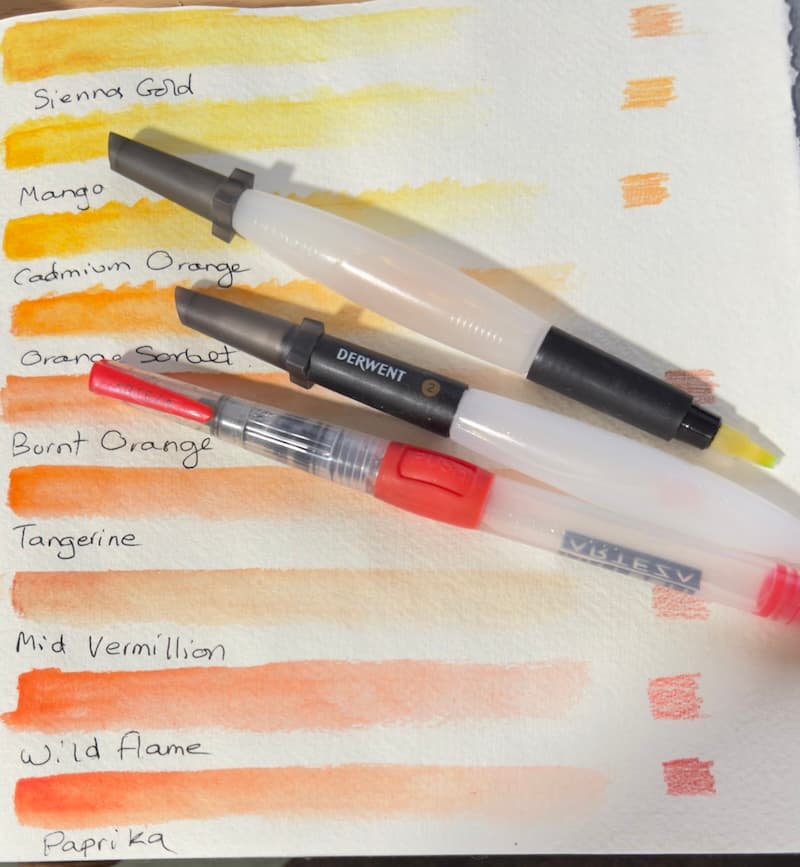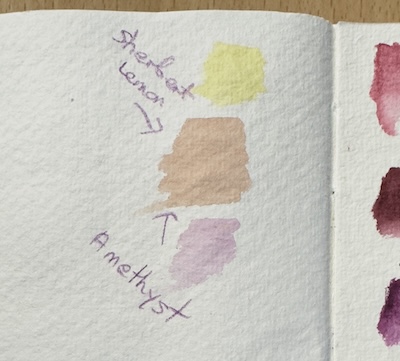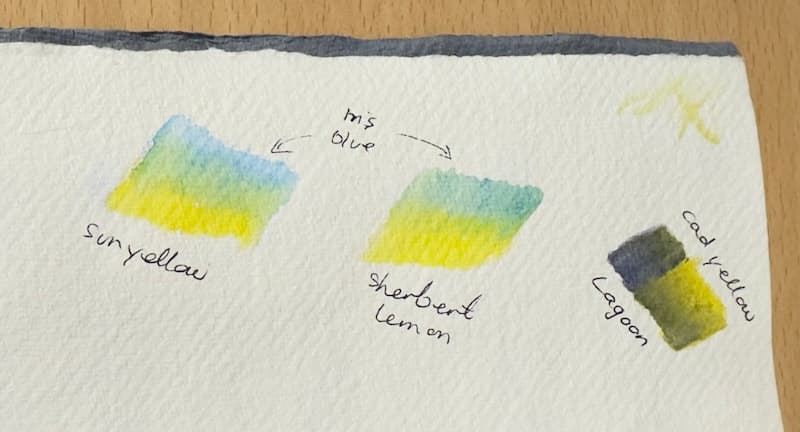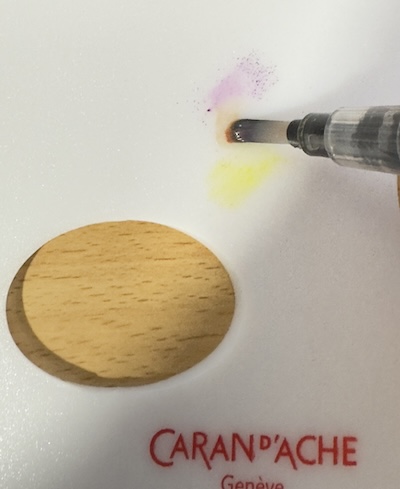- Home
- Resources
- Choosing pencil brands
- Derwent Inktense
Getting to Know Inktense Pencils
As a coloured pencil artist, I adore the endless possibilities that come with layering. There’s something so satisfying about building up rich, velvety tones with each careful stroke.
Watercolour pencils offer a taste of that layering joy, but there’s a catch. Have you ever noticed how adding another layer can sometimes disturb the pigment below? One moment you’re layering, and the next you’re making a right mess as the new colour mixes with the old.
Enter Derwent Inktense Pencils
Now, let me introduce you to Inktense pencils (affiliate link) by Derwent. Unlike traditional watercolour pencils, these use water-soluble ink. Once activated and dried, the ink becomes permanent. You can layer away to your heart’s content without muddying the waters.
But (and isn’t there always a but?) you must ensure the ink is fully activated. Even a tiny dry dot can reactivate with the next wash, potentially wreaking havoc on your work.
Patience is essential. Wait until each layer is bone dry before adding more ink. Rushing on damp paper causes unwanted bleeding and blending. I've learned this the hard way!
This doesn't mean wet-in-wet techniques are off-limits. In fact, blending while wet creates stunning soft gradients and unexpected colour mixes. Just remember, once you’re happy with the effect, let that layer dry completely before working on top of it.
Waiting in the Wings
Here’s the funny part: I had a tin of Inktense pencils sitting in my studio for ages before I finally gave them a go.
I’d heard about their intense, bright colours, which put me off. I mainly paint landscapes and animals, not subjects known for neon hues.
One day, I finally experimented. I immediately regretted not trying them sooner!
The colours are vibrant, but I discovered they could be beautifully toned down. By mixing pigment with plenty of water, often on a palette, I achieved soft, natural hues.
In other words, those intense colours were more versatile than I’d initially given them credit for. With a few careful layers, a bit of blending, and plenty of drying time, suddenly these pencils found their place in my landscape and wildlife work.
 Some of the neutral hues available
Some of the neutral hues availableCan You Use Derwent Inktense Pencils on Fabric?
One of the most exciting discoveries I made with Inktense pencils is that they can be used on fabric, including delicate materials like silk! The permanent ink adheres beautifully, opening up a world of textile art possibilities.
My first project was a nativity scene on silk for a Christmas card. The vibrant colours and smooth silk allowed for lovely blends and fine details.
When it comes to choosing fabrics, natural fibres like silk, cotton, and linen work best. I always prefer to pre-wash in case of shrinkage.
To begin, I tape my fabric down on my light pad and trace the outlines using a water-soluble graphite pencil or the Derwent Inktense outliner pencil (included in your tin), which creates crisp lines that don't disolve.
Prefer Working on Paper?
Choosing the right paper makes a world of difference when working with Inktense pencils. Since these pencils transform into vibrant, water-soluble ink, your paper needs to handle moisture well. Here are some options:
- Inktense Paper: Derwent's 300gsm Inktense paper, similar in texture to NOT (cold-pressed) watercolour paper, is thick enough to prevent buckling and has a texture that grips the pigment.
- Khadi Paper: My swatches were done on 200gsm Khadi, a handmade 100% cotton paper. Its wonderful texture holds pigment and withstands water. Though not as thick as Inktense paper, it's ideal for experimenting.
- Mixed Media Paper: A more affordable option, look for at least 200gsm mixed media paper. It might not handle as many layers, but it’s great for practice.
Note: The links above are affiliate links. If you use them to make your purchase you help support this site without paying any extra.
Avoid thin sketch paper, printer paper, and low-quality watercolour paper.
Tape down lighter-weight papers. Always test first. I enjoy the texture of Khadi or NOT paper, but have to ensure all the pigment is activated, as it can get trapped in the paper's tooth.
Painting With Inktense Pencils
To turn your drawing into a painting you will need an assortment of brushes.
Your brush choice influences pigment activation, spread, and blending. Here are some brush types to consider along with tips on when to use them:
- Round Brushes: Small rounds (size 4 or 6) are ideal for controlled activation; larger rounds (size 8 or 10) for broad washes. They're excellent for details and blending small areas.
- Flat Brushes: Small to medium flats (size 6 or 8) cover larger areas or create straight edges. They're ideal for even washes and defined lines.
- Water Brushes: These have a refillable water reservoir, perfect for outdoor sketching. Derwent’s own brand works exceptionally well.
- Detail Brushes: Sizes 0 to 2 are perfect for fine details like fur or feathers.
 My water brush collection
My water brush collectionTips for Using Brushes with Inktense
- Control Your Water Flow: Too much water can cause the pigment to spread uncontrollably, while too little may leave the pigment only partially activated. Therefore, practice on a scrap piece of paper to get a feel for the right water balance.
- Clean Your Brushes Frequently: To avoid muddy colours, rinse your brushes regularly or squeeze clean water through a water brush to clear away any residual pigment.
- Blot Excess Water: If you’ve applied too much water, use a paper towel or cloth to gently blot away the excess and regain control.
- Combine Brush Types: Use a water brush for the initial washes when sketching outdoors, and then switch to round or detail brushes for more controlled work when you’re back in the studio.
The Benefits of Mixing on a Palette
Mixing Derwent Inktense pencils on a palette offers greater control over colour intensity and subtle variations, especially for soft washes and custom colours.
- Control Intensity: By mixing on a palette, you can easily adjust the strength or dilution of the pigment before applying it to the paper. This is particularly useful for achieving soft, pale hues that would be challenging to create with when directly applying the pencil to the paper.
- Create Custom Colours: You can mix two or more Inktense colours to create entirely new shades, thereby expanding your palette without needing more pencils.
- Smooth Application: Pre-mixing the pigment on a palette allows for smoother, more even washes on the paper. This helps avoid harsh pencil marks or streakiness, enhancing the overall quality of your artwork.
- Layering Flexibility: Controlling the intensity, enables you to build up subtle layers of colour gradually. This is especially beneficial for subjects like landscapes and animals, where you might desire more nuanced tones.

Using the Caran d'Ache palette to mix Sherbert Lemon and Amethyst pencils
How to Use a Palette
You will need:
- Derwent Inktense pencils (you can also use Inktense blocks)
- A water brush or a round brush and water container
- A palette: this could be a plastic palette, a ceramic dish, or even a scrap piece of textured watercolour paper. I treated myself to a Caran d'Ache acrylic palette earlier this month, which has a slightly textured side ideal for Inktense.
Lay Down the Pigment
- Lightly scribble the tip of your Inktense pencil onto the palette surface. Don’t press too hard; a small amount of pigment is all you need to start with.
- You can place multiple colours side-by-side if you’re planning to mix them.
Activate with Water
Dip your brush in clean water and touch it to the pigment on the palette. Swirl gently until the pigment dissolves and forms a puddle of ink.
Adjust the water level to control the intensity:
- More water = softer, lighter washes
- Less water = more vibrant, saturated colour
 Inktense pencils do not have to be intense!
Inktense pencils do not have to be intense!Mix Colours
- Want to blend two colours? Dissolve each pigment separately, then mix them together on the palette with your brush.
- For example, mix Iris Blue and Sun Yellow to create soft shades of green, or blend Cadmium Yellow and Lagoon for darker, more realistic greens.
 Mixing greens on the paper
Mixing greens on the paperApply to Paper
- Once you’re happy with the colour, brush it onto your paper. This method gives you significant control, allowing you to paint more like you would with traditional watercolours.
- Start with light washes and build up gradually for more depth.
Ready to Explore a Whole New Layer of Creativity?
If you’ve been eyeing that tin of Inktense pencils with suspicion—or just avoiding them because you think they’re too intense—it might be time to give them a whirl.
Yes, they’re called Inktense for a reason, but with a splash of water (and a bit of patience), you can tame those colours into subtle, natural tones perfect for your landscapes or wildlife.
They’re more versatile than they look, and you might just wonder why you didn’t try them sooner. So go on, dig them out and have a play.
Improve Your Pencil Art: Get Free Tips & Techniques
Sign up for our newsletter – just occasional emails packed with practical advice and inspiration for pencil artists like yourself







